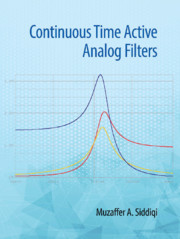Book contents
- Frontmatter
- Dedication
- Contents
- Preface
- Acknowledgments
- 1 Analog Filter: Concepts
- 2 First-and Second-order Filters
- 3 Magnitude Approximations
- 4 Delay: Approximation and Optimization
- 5 Frequency and Impedance Transformations
- 6 Sensitivity of Active Networks
- 7 Single Amplifier Second-order Filters
- 8 Multi Amplifier Second-order Filter Sections
- 9 Direct Form Synthesis: Element Substitution and Operational Simulation
- 10 Cascade Approach: Optimization and Tuning
- 11 Amplification and Filtering in Biomedical Applications
- 12 Audio Signal Processing and Anti-aliasing Filters
- 13 Follow the Leader Feedback Filters
- 14 Switched Capacitor Circuits
- 15 Operational Transconductance Amplifier-C Filters
- 16 Current Conveyors and CDTA (Current Differencing Transconductance Amplifiers) Based Filters
- 17 Active R and Active C Filters
- Index
14 - Switched Capacitor Circuits
Published online by Cambridge University Press: 24 December 2019
- Frontmatter
- Dedication
- Contents
- Preface
- Acknowledgments
- 1 Analog Filter: Concepts
- 2 First-and Second-order Filters
- 3 Magnitude Approximations
- 4 Delay: Approximation and Optimization
- 5 Frequency and Impedance Transformations
- 6 Sensitivity of Active Networks
- 7 Single Amplifier Second-order Filters
- 8 Multi Amplifier Second-order Filter Sections
- 9 Direct Form Synthesis: Element Substitution and Operational Simulation
- 10 Cascade Approach: Optimization and Tuning
- 11 Amplification and Filtering in Biomedical Applications
- 12 Audio Signal Processing and Anti-aliasing Filters
- 13 Follow the Leader Feedback Filters
- 14 Switched Capacitor Circuits
- 15 Operational Transconductance Amplifier-C Filters
- 16 Current Conveyors and CDTA (Current Differencing Transconductance Amplifiers) Based Filters
- 17 Active R and Active C Filters
- Index
Summary
Introduction
To meet the advances in technology, realization of monolithic electronic analog filters became an important issue. In the beginning, the problem of inductance realization was solved through its simulation using active RC circuits. However, integration needed the solution of a few more problems such that the realized filters perform as close to the design as possible. One of the main issues faced while integrating circuits was the amount of tolerance in passive elements; it was too large. This large tolerance resulted in large errors in the realized filter parameters. These errors could be reduced through electronic tuning of components or the tuning of filter parameters, with an obvious increase in circuit complexities. It was observed that the need of electronic tuning could be reduced through schemes in which filter parameters depend on the ratio of passive components, especially capacitors, as capacitor ratio tolerance is much better in integrated circuits. Switched capacitor filter (SCF) realization technique is one such scheme in which all filter parameters depend on capacitor ratios. Equally important is the fact that switched capacitor (SC) schemes do not use external resistors. This saved a large amount of chip area; a highly attractive feature for integrated circuits.
In this chapter, the basic concepts of SCF realization will be discussed. One important approach is the simulation of grounded and floating resistors using capacitors, switches, and non-overlapping clock signals. Such a realization and its simple applications including integrators are shown in Sections 14.2 and 14.3. As switches and clocks are the basic components of integrated circuits, these are further studied in Section 14.4. The rest of the chapter covers the topic of first- and second-order SCF sections.
Switched Capacitor Resistor
Let us examine a simple circuit as shown in Figure 14.1(a), containing two switches and a capacitor CR. The port voltages are v1 and v2, and the two switches become ON and OFF continuously at a certain clock frequency fc. This means that each switch can remain on for a maximum time duration Tc = 1/2 fc. It is further assumed that either voltages v1 or v2 will remain constant during the small duration Tc when either of the switches is ON.
- Type
- Chapter
- Information
- Continuous Time Active Analog Filters , pp. 424 - 452Publisher: Cambridge University PressPrint publication year: 2020



